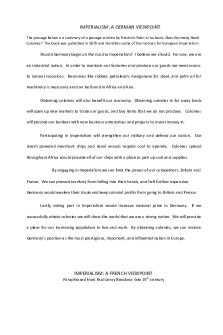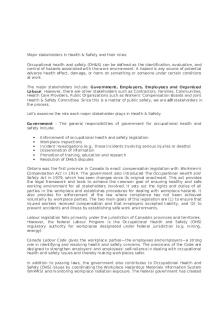Discrepancies in households and other stakeholders viewpoints on the food security experience: a gap to address PDF

| Title | Discrepancies in households and other stakeholders viewpoints on the food security experience: a gap to address |
|---|---|
| Author | Annie Bedard |
| Pages | 12 |
| File Size | 381.8 KB |
| File Type | |
| Total Downloads | 5 |
| Total Views | 551 |
Summary
Health Education Research Advance Access published June 29, 2009 HEALTH EDUCATION RESEARCH Pages 12 Discrepancies in households and other stakeholders viewpoints on the food security experience: a gap to address Anne-Marie Hamelin1*, Céline Mercier2 and Annie Bédard1 Abstract holds’ experience and...
Description
Health Education Research Advance Access published June 29, 2009 HEALTH EDUCATION RESEARCH Pages 12
Discrepancies in households and other stakeholders viewpoints on the food security experience: a gap to address Anne-Marie Hamelin1*, Ce´line Mercier2 and Annie Be´dard1 Abstract This paper reports results from a case study on household food insecurity needs and the interventions that address them. It aimed at comparing households’ perceptions on food insecurity experience and vulnerability to those of other stakeholders: community workers, programme managers and representatives from donor agencies. Semi-structured interviews with 55 households and 59 other stakeholders were conducted. Content analysis was performed, using a framework encompassing food sufficiency, characterization of household food insecurity and vulnerability of households to food insecurity. Overall, the results draw attention to a gap between households and the other stakeholders, where the later do not seem always able to assess the realities of food-insecure households. Other areas of divergences include: characteristics of food insecurity, relative importance of various risk factors related to food insecurity and the effectiveness of the community assistance to enhance the households’ ability to face food insecurity. These divergent perceptions may jeopardize the implementation of sustainable solutions to food insecurity. Training of stakeholders for a better assessment of house1
Department of Food Sciences and Nutrition, Pavillon PaulComtois, Universite´ Laval, 2425 rue de l’Agriculture, Que´bec, QC, Canada G1V 0A6 and 2Department of Social and Preventive Medicine, Faculte´ de Me´decine, Universite´ de Montre´al, C.P. 6128, succursale Centre-Ville, Montre´al, QC, Canada H3C 3J7 *Correspondence to: A.-M. Hamelin. E-mail: [email protected]
holds’ experience and needs, and systematic evaluation of interventions, appear urgent and highly relevant for an adequate response to households’ needs. Collaboration between all stakeholders should lead to knowledge sharing and advocacy for policies dedicated to poverty reduction.
Introduction The persistence of socio-economic inequalities and poverty in Canada accentuates the vulnerability of households [1, 2] and clearly contributes to food insecurity [2–8], a phenomenon which affects ;1 Canadian household in 11 [8]. Despite the fact that previous studies have documented a variety of risks factors involved and the importance of decent income to insure food security [8–13], the current response to food insecurity remains food donations [9, 10] and, more recently, participatory activities such as collective kitchens [16–19]. Derived effects from these collective kitchens, such as individual empowerment and skill building [11, 12], mutual aid and socio-economic development [12, 13] or the generation of social values and psychological resources [14], have been documented. However, few studies have verified how collective kitchens meet the food security needs of households [12,15– 18]. Although they may improve food resources, they appear to have limited potential to substantially improve income-related food security [6,15–17]. Overall, according to recent reports [1–8], despite an increasing number and variety of interventions,
Ó The Author 2009. Published by Oxford University Press. All rights reserved. For permissions, please email: [email protected]
doi:10.1093/her/cyp033
A.-M. Hamelin et al. food insecurity remains widespread [10]. This situation raises the question to what degree the available interventions correspond with the realities experienced by food-insecure households, among whom many have to rely on food assistance. Within a case study of the fit between food security interventions and the needs of food-insecure households in the Quebec City area [19], a comparison was done between household members’ perceptions and those of other stakeholders (community workers, programme managers and representatives from donor agencies) regarding the experience of household food insecurity.
Methods A naturalistic strategy was adopted, based on qualitative data [20]. A diversity of food-insecure households were sampled and recruited through community organizations, newspaper advertisements and flyers in targeted neighbourhoods with various socio-economic characteristics (e.g. households from different study areas, various household types, households participating and non-participating in community programmes for food security). Interested households contacted the research assistant and their food-insecurity status was verified using the Radimer/Cornell Index [21], as well as their household type (bi- or monoparental, couple without children at home, single person) and food sources (whether or not they were using community programmes and/or food banks to get food; if yes, enumeration of these sources). Households were considered food insecure if they reported at least one positive item from the Radimer/Cornell Index. Food secure households, homeless persons, drug addicts, persons aged 75 years or older and persons living in institutions were not included, to ensure that the participants reflect the mainstream food-insecure households. In addition, three stakeholder groups other than households were targeted among the community organizations in the area of the study: ‘community workers’ working directly with poor food-insecure households in community pro2 of 12
grammes such as collective kitchens, food purchase groups and community gardens; ‘managers’ of organizations administering these food security measures or assistance to the poor and representatives from ‘donor agencies’ that support various food security activities. A trained interviewer audio-recorded semistructured, individual interviews with an adult representative from the selected households. Another trained interviewer did the same with the other stakeholders. All participants were asked to describe the household experience of food insecurity, its manifestations and influencing factors. Sociodemographic and economic information were also gathered by questionnaire to profile the participants. A written consent form was read, discussed and signed by all participants who also had the opportunity to ask questions about the study. After their transcription in full, interviews were subjected to content analysis using NVivo 2.0. The coding scheme, as well as the interview guide, were built using a conceptual framework developed as part of an ethnographic study on household food insecurity [22, 23]. This framework encompasses three notions: food sufficiency, characterization of household food insecurity and vulnerability of households to food insecurity. The ‘food sufficiency’ part of the framework has been used more deeply to describe participants’ perceptions of households’ needs for an adequate and stable food situation, which constitute another part of our study that is described elsewhere [19]. ‘Characterization of food insecurity’ highlights the central characteristics of the experience (preoccupation with access to food; quantitative shortage of food; unsuitable quality of food and diet and alienation, i.e. lack of control over food situation), several aspects of its dynamic nature and potential reactions to a lack of food (socio-familial perturbations, hunger and physical impairment, psychological suffering). ‘Vulnerability’ relates food insecurity’s influencing factors, i.e. various risks inside three main categories (structural, contextual, proximal) and the assets that build the households’ capacity to face those risks. Structural risks are more or less ‘immutable’ factors such as the number of children in
Food insecurity—comparison of viewpoints a household; contextual risks refer to core circumstances characterizing the life of households; proximal risks are factors that suddenly exert great pressure on the household micro-system food situation. In addition to the themes from the conceptual framework, the coding scheme was also enriched by themes that emerged, especially among the risks and assets to face those risks, thus allowing the creation of additional subcategories inside the main categories of the framework. Analysis led to a synthesis of the households’ experience of food insecurity and a comparison of their viewpoint with that of the other stakeholders. In order to cover the topic properly, the interview schedule included both open-ended questions and a predetermined set of sub-questions about several aspects of food insecurity. Inter-coder reliability was measured over a sample of interviews with households (n = 4), community workers (n = 5), managers (n = 3) and donor agencies (n = 2), coded by two team members [24]. Reliability, before discussion of disagreements, was on average 70, 79, 66 and 81%, respectively. All disagreements were entirely resolved through discussion with the principal researcher. The fact that the final household interviews yielded no new ideas suggests an attainment of theoretical saturation. The triangulation of perspectives adds credibility to the data. Furthermore, analysis process and results were regularly discussed between team members through debriefing sessions. Taken together, the theoretical basis of the interview schedule, the care taken in the interview and analysis processes, the type of sample and its size and the theoretical saturation contribute to meeting Guba and Lincoln’s ‘trustworthiness’ criterion [25]. To verify their credibility, results were also respectively submitted to a group of households (n = 3) and a group of other stakeholders (n = 13) in a session during which an open discussion was held by two authors (A.-M.H. and A.B.). These group sessions confirmed the main results and helped to fine-tune their interpretation. The study was approved by the Research ethics committees of Universite´ Laval and of the Centre de sante´ et des services sociaux de la VieilleCapitale.
Results Fifty-five household representatives (31 who participated in food security programmes and 24 who did not) as well as 59 other stakeholders were interviewed. Their socio-demographic and economic characteristics and usage of food assistance are presented in Tables I and II. Household representatives were largely women (80%), with an annual income generally...
Similar Free PDFs

FOOD Security
- 4 Pages

Food Security Booklet min
- 19 Pages

Families and Households
- 36 Pages

Families and Households 11
- 1 Pages

Find my IP address on a Mac
- 2 Pages

Culture and food in the UAE
- 11 Pages
Popular Institutions
- Tinajero National High School - Annex
- Politeknik Caltex Riau
- Yokohama City University
- SGT University
- University of Al-Qadisiyah
- Divine Word College of Vigan
- Techniek College Rotterdam
- Universidade de Santiago
- Universiti Teknologi MARA Cawangan Johor Kampus Pasir Gudang
- Poltekkes Kemenkes Yogyakarta
- Baguio City National High School
- Colegio san marcos
- preparatoria uno
- Centro de Bachillerato Tecnológico Industrial y de Servicios No. 107
- Dalian Maritime University
- Quang Trung Secondary School
- Colegio Tecnológico en Informática
- Corporación Regional de Educación Superior
- Grupo CEDVA
- Dar Al Uloom University
- Centro de Estudios Preuniversitarios de la Universidad Nacional de Ingeniería
- 上智大学
- Aakash International School, Nuna Majara
- San Felipe Neri Catholic School
- Kang Chiao International School - New Taipei City
- Misamis Occidental National High School
- Institución Educativa Escuela Normal Juan Ladrilleros
- Kolehiyo ng Pantukan
- Batanes State College
- Instituto Continental
- Sekolah Menengah Kejuruan Kesehatan Kaltara (Tarakan)
- Colegio de La Inmaculada Concepcion - Cebu









